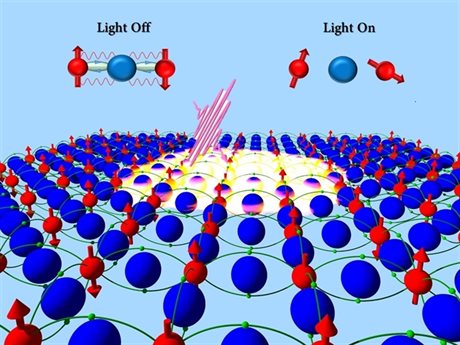16 September 2015
An international team led by Radboud University physicists has discovered that reversing the poles of magnets must be possible without a heating or a magnetic field.. A strong pulse of light can have a direct effect on the strong quantum mechanical ‘exchange interaction’, therefore changing the magnetism (Nature Communications, 16 September 2015).
In 2007, Professor Rasing and his group at Radboud University showed for the first time that fast pulses of laser light can reverse the poles of magnets. This was a paradigm shift as, until then, physicists believed that light could never be strong enough to break the strong magnetic interaction forces. It can, however, and very local heating by the laser pulse in combination with differences in the response times of the constituent atoms can explain this phenomenon. The researchers have now discovered a new way in which light can manipulate magnetisation.
Directly on the electrons
In the article published by Nature Communications on September 16 the researchers show that the light can excite electrons, which in turn can directly influence the strength of the exchange interaction and therefore change the magnetisation. No heat is released in the process, which is good news for magnetic data storage applications as it means that the method requires little energy. Exchange interaction refers to the internal, quantum mechanical forces that make a magnet magnetic.
“We carried out our experiments in iron oxides, including hematite,” says project leader Alexey Kimel. “The crystal structure of hematite is a good system to study this mechanism, as the iron ions are neatly separated by oxygen ions in the crystal lattice. Even so, exchange interaction takes place between the iron ions because the electrons interact through the oxygen ions. By exciting the electrons in the oxygen with a pulse of light, we can manipulate the exchange interaction between the iron spins, and perhaps even reverse their polarity in the near future.”
Cool savings
Switching with no heat has the potential to revolutionise magnetic data storage. Huge amounts of heat are currently released in large data centres, and good cooling is becoming a big problem. Facebook, for example, is planning to build its new data centre in the north of Sweden for this very reason. “If we can store information using a new, cool method, data storage will be a lot cheaper,” explains Kimel.
Measure what you do
The researchers also developed a magnetometer to measure the ultrafast changes they induce in a magnet. They use the freely propagating electromagnetic radiation in the Terahertz frequency range (1 THz = 1012 Hz) emitted by the spins of the magnet. By measuring the changes in this radiation, they are able to measure the effect of light on the magnetisation. “We have produced a magnetometer that measures at the femtosecond scale,” says Rostislav Mikhaylovskiy, the first author of the article.
To be continued at FELIX and HFML
The researchers will conduct further studies into switching using light in the new FELIX laser lab and the adjacent HFML in Nijmegen. The strength of magnetic fields generated by HFML is comparable to that of the exchange interaction and the frequency of light waves generated by FELIX can be tuned to affect the electrons and change the strength of the exchange interaction in the most effective way. “This will certainly help us explore this mechanism in greater detail,” says Theo Rasing.
The FELIX laser lab will be officially opened on 30 October by the Dutch State Secretary for Education, Culture and Science, Sander Dekker. International science journalists are welcome to join a two day physics excursion at Radboud University on 5-6 November.
- Ultrafast optical modification of exchange interactions in iron oxides
DOI: 10.1038/ncomms9190, Nature Communications. 16 September 2015
http://www.ru.nl/english/news-agenda/vm/physics/2015/new-route-switching/















